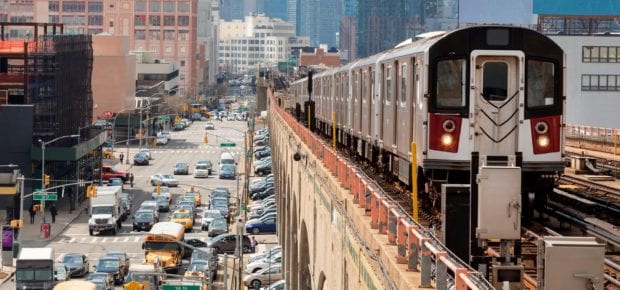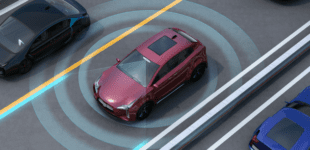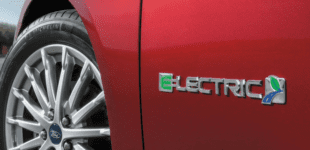February 12, 2019
As cities continue to grow, the role of public transportation shows no sign of lessening. Whether it’s moving people within cities on buses or subways, or between cities via trains, engineers and technologists are looking for ways to make transit infrastructure more efficient for everyone.
It’s worth noting off the bat that a key benefit of public transit is its efficiency. In an opinion piece in January’s issue of IEEE Spectrum, author Vaclav Smil breaks down the energy intensity of different travel options. “When I’m the only passenger in my Civic,” he says, “it requires about 2 megajoules per passenger-kilometer in city driving. Add another passenger and that figure drops to 1 MJ/pkm, comparable to a half-empty bus.” Smil continues: “Of course, public-transit trains are far superior: At high passenger loads, the best subways need less than 0.1 MJ/pkm.”
The numbers make it clear that mass transit options have less environmental impact per passenger than a car. However, there’s still a lot of room to improve efficiency.
For buses, researchers in China and the U.K. have been using machine learning to help drivers reduce fuel consumption. Since driving styles can have a huge impact on efficiency (up to 30% in an urban environment, according to the journal article), providing the driver with real-time assistance can encourage them to optimize for fuel efficiency.
Displaying prompts for shifting gears, changing the gradient of the accelerator pedal and changing the pedal’s average depth can help the driver make positive changes. And machine learning can be used to display the option closest to the operator’s driving style, increasing the likelihood that they adhere to the suggestions. In total, the researchers say, “the LPP algorithm can guide the driver to increase the fuel economy by 6.25% under the premise that the driving task is basically unchanged.”
When it comes to subways, safety is consistently one of the biggest concerns. While subway systems have been incorporating shallow neural networks to reduce accidents, there’s significant potential to use deep learning to provide superior results. In a paper submitted to the 2017 IEEE/ACIS International Conference on Computer and Information Science (ICIS), researchers introduced user satisfaction and rare-event probability into their safety prediction model, greatly increasing the accuracy.
High-speed rail projects capture the public imagination, but can be time intensive to roll out. According to IEEE Spectrum, this year, East Japan Railways plans to test a new generation of bullet trains, the Alfa-X, capable of topping 400 km/h. While the company may limit the operating speed to 360 km/h, that’s more than 10% faster than today’s trains. Meanwhile, they say, “Morocco is finally on track to put its first high-speed train into operation by early 2019, an effort that has been plagued by delays. Tests in 2018 pushed that train’s speed to 357 km/h, a record for Africa.”
With such extreme speeds, there’s the question of how to reliably relay wireless data to these machines. An article published in IEEE Access explains how high-speed railway communication (HSRC), which “delivers information not only for special applications such as train scheduling control and safety monitoring but also for public applications such as internet services for passengers,” can be improved through different methods of power allocation.
If you want to learn more or get involved, we have both the IEEE Intelligent Transportation Systems Society (ITSS) and the IEEE Transportation Electrification Community (TEC) focused on making transportation more efficient. The ITSS works on transportation systems of all kinds, while the TEC deals with the electrification of cars, ships, aircraft and more.





 Meaningful Momentum or Running in Place?
Meaningful Momentum or Running in Place? AI Through Our Ages
AI Through Our Ages Liquid Infrastructure: Our Planet's Most Precious Resource
Liquid Infrastructure: Our Planet's Most Precious Resource The Impact of Technology in 2025
The Impact of Technology in 2025 Quantum and AI: Safeguards or Threats to Cybersecurity?
Quantum and AI: Safeguards or Threats to Cybersecurity? Why AI Can't Live Without Us
Why AI Can't Live Without Us Bits, Bytes, Buildings and Bridges: Digital-Driven Infrastructure
Bits, Bytes, Buildings and Bridges: Digital-Driven Infrastructure Impact of Technology in 2024
Impact of Technology in 2024 Emerging AI Cybersecurity Challenges and Solutions
Emerging AI Cybersecurity Challenges and Solutions The Skies are Unlimited
The Skies are Unlimited Smart Cities 2030: How Tech is Reshaping Urbanscapes
Smart Cities 2030: How Tech is Reshaping Urbanscapes Impact of Technology 2023
Impact of Technology 2023 Cybersecurity for Life-Changing Innovations
Cybersecurity for Life-Changing Innovations Smarter Wearables Healthier Life
Smarter Wearables Healthier Life Infrastructure In Motion
Infrastructure In Motion The Impact of Tech in 2022 and Beyond
The Impact of Tech in 2022 and Beyond Cybersecurity, Technology and Protecting Our World
Cybersecurity, Technology and Protecting Our World How Technology Helps us Understand Our Health and Wellness
How Technology Helps us Understand Our Health and Wellness The Resilience of Humanity
The Resilience of Humanity Harnessing and Sustaining our Natural Resources
Harnessing and Sustaining our Natural Resources Creating Healthy Spaces Through Technology
Creating Healthy Spaces Through Technology Exceptional Infrastructure Challenges, Technology and Humanity
Exceptional Infrastructure Challenges, Technology and Humanity The Global Impact of IEEE's 802 Standards
The Global Impact of IEEE's 802 Standards Scenes of our Cyber Lives: The Security Threats and Technology Solutions Protecting Us
Scenes of our Cyber Lives: The Security Threats and Technology Solutions Protecting Us How Millennial Parents are Embracing Health and Wellness Technologies for Their Generation Alpha Kids
How Millennial Parents are Embracing Health and Wellness Technologies for Their Generation Alpha Kids Space Exploration, Technology and Our Lives
Space Exploration, Technology and Our Lives Global Innovation and the Environment
Global Innovation and the Environment How Technology, Privacy and Security are Changing Each Other (And Us)
How Technology, Privacy and Security are Changing Each Other (And Us) Find us in booth 31506, LVCC South Hall 3 and experience the Technology Moon Walk
Find us in booth 31506, LVCC South Hall 3 and experience the Technology Moon Walk Virtual and Mixed Reality
Virtual and Mixed Reality How Robots are Improving our Health
How Robots are Improving our Health IEEE Experts and the Robots They are Teaching
IEEE Experts and the Robots They are Teaching See how millennial parents around the world see AI impacting the lives of their tech-infused offspring
See how millennial parents around the world see AI impacting the lives of their tech-infused offspring Take the journey from farm to table and learn how IoT will help us reach the rising demand for food production
Take the journey from farm to table and learn how IoT will help us reach the rising demand for food production Watch technical experts discuss the latest cyber threats
Watch technical experts discuss the latest cyber threats Explore how researchers, teachers, explorers, healthcare and medical professionals use immersive technologies
Explore how researchers, teachers, explorers, healthcare and medical professionals use immersive technologies Follow the timeline to see how Generation AI will be impacted by technology
Follow the timeline to see how Generation AI will be impacted by technology Learn how your IoT data can be used by experiencing a day in a connected life
Learn how your IoT data can be used by experiencing a day in a connected life Listen to technical experts discuss the biggest security threats today
Listen to technical experts discuss the biggest security threats today See how tech has influenced and evolved with the Games
See how tech has influenced and evolved with the Games Enter our virtual home to explore the IoT (Internet of Things) technologies
Enter our virtual home to explore the IoT (Internet of Things) technologies Explore an interactive map showcasing exciting innovations in robotics
Explore an interactive map showcasing exciting innovations in robotics Interactively explore A.I. in recent Hollywood movies
Interactively explore A.I. in recent Hollywood movies Get immersed in technologies that will improve patients' lives
Get immersed in technologies that will improve patients' lives